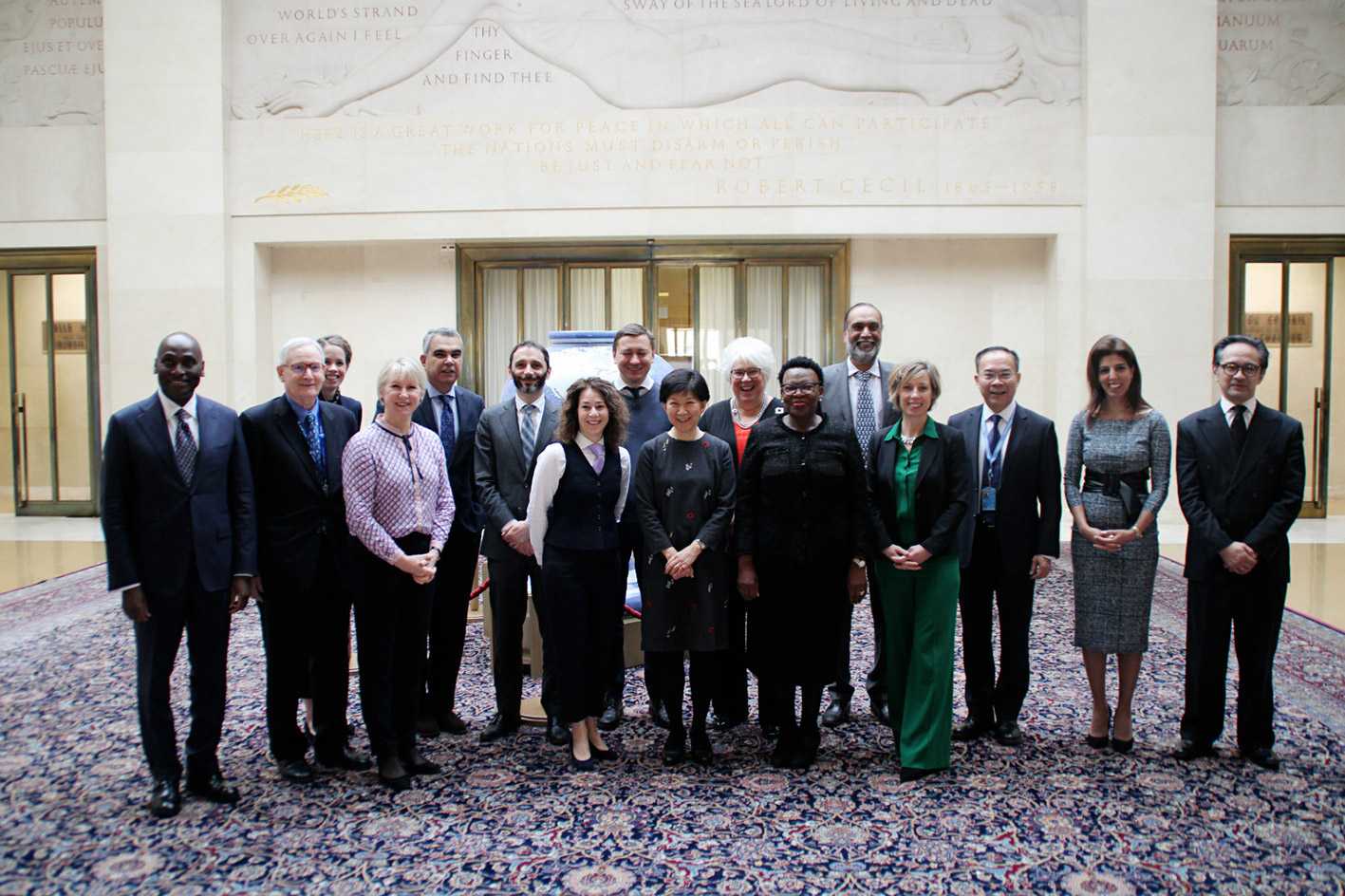Supporting elements of the UN Disarmament Machinery
The UN Institute for Disarmament Research (UNIDIR)
The UN Institute for Disarmament Research (UNIDIR) is an autonomous research institute established by the General Assembly in 1980 1 following SSOD-I. It organizes experts’ meetings, conducts and publishes research projects, and develops collaborations with governmental and non-governmental organizations, civil society, and the private sector on disarmament and related problems.
Its current research agenda, adopted in 2018, covers five areas:2
- and other strategic weapons
- Conventional arms
- Security and technology
- Gender and disarmament
- Middle East Free Zone
UNIDIR’s activites are overseen by the Advisory Board on Disarmament Matters.
The Advisory Board on Disarmament Matters (ABDM)

The members of the Advisory Board on Disarmament. Geneva, January 2020.
The Advisory Board on Disarmament Matters is a group of fifteen experts on disarmament and international security appointed by the UN secretary-general. The board serves three main functions:
- To serve as the board of trustees of UNIDIR, reviewing projects, financial and personnel-related matters;
- To advise the secretary-general on matters of arms limitation and disarmament
- To advise the UN secretary-general on the implementation of the UN Disarmament Information Programmme.
The board was established by SSOD-I 1978 and received its current mandate in 1999 through the General Assembly’s decision 54/418. It meets twice a year, alternating between New York and Geneva.3
UN Office of Disarmament Affairs (UNODA)
Established in 1982 following the recommendation of the second Special Session on Disarmament (SSOD-II), the UN Office of Disarmament Affairs provides substantive and organizational support to other parts of the Disarmament Machinery (including the Conference on Disarmament) and UN member states.
Its ares of work include the facilitation of multilateral dialogue, transparency and confidence-building measures, the provision of impartial and up-to-date information on arms control and disarmament issues, outreach, and education.
Regional Centres for Peace and Disarmament
The UN runs three Regional Centres for peace and disarmament to further its disarmament agenda in Africa, Asia, and Latin America. They are supported by the Office of Disarmament Affairs.
The UN Regional Centre for Peace and Disarmament in Africa (UNREC)
UNREC was established by the General Assembly in 1986 and is headquartered in Lomé, Togo. UNREC supports member states of the African region in their efforts to maintain peace, arms limitation and disarmament. UNREC cooperates with the African Union on the implementation of regional disarmament activities. 4
The United Nations Regional Centre for Peace and Disarmament in Asia and the Pacific (UNRCPD)
Established by the General Assembly in 1987, UNRCPD assists 43 countries in the region in their efforts to promote and implement peace, security and disarmament goals through education programmes, the promotion of dialogue, confidence-building measures and the organization of major annual conferences. Its headquarters are located in Kathmandu, Nepal.
The United Nations Regional Centre for Peace and Disarmament in Latin America and the Caribbean (UNLIREC)
Established by the General Assembly in 1986, UNLIREC supports the thirty-three States of the Latin American and Caribbean region in their implementation of peace and disarmament measures. Its main function is to implement the UN’s decisions, instruments and commitments in the field of disarmament and non-proliferation at national, sub-regional and regional levels. It is headquartered in Lima, Perù.
Other multilateral bodies
Some international bodies, though not formally part of the UN system, are nevertheless considered to be part of the Disarmament Machinery. Their activities are supported by the Office of Disarmament Affairs.
The Preparatory Commission for the Comprehensive Nuclear-Test-Ban Treaty Organization
The Preparatory Comission (established in 1996, 184 member states) is the interim implementing body of the Comprehensive Test Ban Treaty.5
The Organisation for the Prohibition of Chemical Weapons (OPCW)
OPCW (established 1997, 193 member states) is the implementing body of the . It oversees the global endeavor to permanently and verifiably eliminate chemical weapons.
The International Atomic Energy Agency (IAEA)
The International Atomic Energy Agency (established 1957, 171 member states) is responsible for the international safeguards system, a set of technical measures used to verify that states are not diverting nuclear materials and technology into nuclear weapons programmes.
Footnotes
-
G.A. Res. A/RES/34/83M (December 11, 1979) ↩
-
Rep. of the Director of the United Nations Institute for Disarmament Research on the activities of the Institute for the period from January to December 2019 and the proposed programme of work and financial plan for 2020 and 2021, at 3-8, U.N. Doc. A/75/134 (July 1, 2020) ↩
-
https://unrec.org/default/index.php/en/about-unrec/who-we-are ↩
-
The Preparatory Commission for the Comprehensive Nuclear-Test-Ban Treaty Organization (2012): About us, www.ctbto.org/specials/who-we-are ↩
-
Organisation for the Prohibition of Chemical Weapons (2022): OPCW Basics, www.opcw.org/about-us/opcw-basics ↩